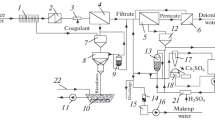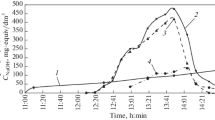Abstract
A highly efficient, economical, and waste-free technology for the purification of natural waters for thermal power plants has been developed. The preliminary purification of water involved microfiltration on tubular ceramic membranes made of clay minerals according to a technology developed at the Dumansky Institute of Colloid Chemistry and Water Chemistry, NAS of Ukraine; the degree of retention of suspended solids and iron and manganese compounds on the membranes was 99.9, 99.8, and 60%, respectively. The high separation capacity of such membranes is due to the modification of their surface by water contaminants with the formation of a self-organizing dynamic membrane that serves as an additional barrier. The dynamic membrane formation contributed to the retention of up to 24.0% of the co-occurring ions, Ca2+ in particular; this is typical for ultrafiltration membranes. Further desalination was performed with low-pressure reverse osmosis membranes; two stages of reverse osmosis turned out necessary to achieve a total ion content of 0.5 mg/dm3 in the make-up water of a steam turbine unit of a thermal power plant (TPP). The retentate of the second stage of reverse osmosis, for which the total ion content is 50–60 mg/dm3, can be used for technical purposes at TPPs. The salt content of the retentate formed after the first stage of reverse osmosis was ~3 g/dm3, and thus insufficient for further transformation into secondary material resources; however, the introduction of waste recycling systems is considered to be the modern direction in protecting the environment from technological influence. The retentate of the first stage of reverse osmosis was concentrated using an original concentrating electrodialyzer developed at the Dumansky Institute of Colloid Chemistry and Water Chemistry, NAS of Ukraine; some design modifications that distinguish this electrodialyzer from the conventional ones were proposed and patented. Electrodialysis treatment of the retentate for 2.5 hours at a current density of 2.5 A/dm3 enabled the production of a solution with the ion content of ~105 g/dm3. This brine can be converted into sodium hypochlorite or caustic soda and hydrochloric acid by electrolysis. The diluate with a mineralization of ~200.5 g/dm3 and a total organic carbon content of ~148.3 g/dm3 can be used for the preparation of coal-water slurry fuels for power generation and metallurgy. The basic technological schemes of make-up water purification for the needs of thermal power plants and the preparation of slurry fuel systems based on coal and reverse osmosis waste that contains organic substances are proposed.



Similar content being viewed by others
REFEERENCES
Kishnevskii, V.A., Tekhnologii podgotovki vody v energetike (Technologies for Water Treatment in Energetic Sector), Odessa, 2008.
Kopylov, A.S., Lavygin, V.M., and Ochkov, V.F., Vodopodgotovka v energetike (Water Treatment in Energetic Sector), Moscow, 2003.
Elizarov, D.P., Teploenergeticheskie ustanovki elektrostantsii (Thermal Engineering Installations for Power Stations), Moscow, 1982, 2nd ed.
Veselovskaya, E.V., Specific treatment of artesian waters for technical water supply to the thermal power stations, Izv. Vyssh. Uchebn. Zaved., Sev.-Kavk. Reg., Tekh. Nauki, 2017, no. 4, pp. 123–128.
Belousova, A.P., Kachestvo podzemnykh vod: sovremennye podkhody k otsenke (Quality of Underground Waters: Modern Approaches to Evaluation), Moscow, 2001.
Guzhulev, E.P., Shalai, V.V., Gritsenko, V.I., and Taran, M.A., Vodopodgotovka i vodno-khimicheskie rezhimy v teploenergetike (Water Treatment and Water-Chemical Modes in Thermal Engineering), Omsk, 2005.
Kopylov, A.S., Ochkov, V.F., and Chudova, Yu.V., Protsessy i apparaty peredovykh tekhnologii vodopodgotovki i ikh programmirovannye raschety (Processes and Devices of Advanced Technologies of Water Treatment and Their Automatic Calculations), Moscow, 2009.
Panteleev, A.A., Ryabchikov, B.E., Khoruzhii, O.V., Gromov, S.L., and Sidorov, A.R., Tekhnologii membrannogo razdeleniya v promyshlennoi vodopodgotovke (Technologies of Membrane Separation in Industrial Water Treatment), Moscow, 2012.
Khalatov, A.A., Energetics of Ukraine: current state and prospects, Visn. Nats. Akad. Nauk Ukr., 2016, no. 6, pp. 53–60.
Vol’chyn, I.A., Dunaevska, N.I., Gaponich, L.S., Chernyavskii, M.V., Topal, O.I., and Zasyad’ko, Ya.I., Perspektivi vprovadzhennya chistikh vugil’nykh tekhnologii v energetiku Ukraini (Prospective Use of Clean Coal Technologies in Energetics of Ukraine), Kyiv, 2013.
Khalatov, A.A., Karp, I.N., and Kutsan, Yu.G., Energy gas turbine engineering: prospective use in the energy sector of Ukraine, Visn. Nats. Akad. Nauk Ukr., 2015, no. 11, pp. 52–58.
Makarov, A.S., Prospective development and use of coal water fuel, Ekotekhnol. Resursosberezheniya, 2018, no. 2, pp. 3–8.
Dubrovina, L.V., Dulneva, T.Yu., and Samsoni-Todorov, O.O., TU U 29.2-05417348-014:2014. Membrany keramichni “Kerama” (TU U 29.2-05417348-014:2014: Ceramic Membranes Kerama), Kyiv, 2015.
Goncharuk, V.V., Kucheruk, D.D., Balakina, M.N., and Dulneva, T.Yu., Water treatment by baromembrane methods on ceramic membranes, J. Water Chem. Technol., 2009, vol. 31, no. 6, pp. 396–404.
Unifitsirovannye metody issledovaniya kachestva vod. Chast’1. Metody khimicheskogo analiza vod (Unified Study Methods of Water Quality, Part 1: Chemical Analysis of Waters), Moscow, 1987, vol. 1.
Alemasova, A.S., Rokun, A.N., and Shevchuk, I.A., Analiticheskaya atomno-absorbtsionnaya spektroskopiya (Analytical Atomic Absorption Spectroscopy), Donetsk, 2003.
Kalyukova, E.N., Osaditel’noe i kompleksonometricheskoe titrovanie. Metodicheskie ukazaniya k laboratornoi rabote (Precipitation and Complexometric Titration: Methods of Laboratory Studies), Ulyanovsk, 2002.
Mulder, M., Basic Principles of Membrane Technology, New York: Springer, 1996.
Goncharuk, V.V., Balakina, M.M., Kucheruk, D.D., Badekha, V.P., Skubchenko, V.F., Samsoni-Todorov, O.O., and Zaritskii, K.O., Low pressure reverse osmosis and nanofiltration in water purification and desalination, Dop. Nats. Akad. Nauk Ukr., 2005, no. 2, pp. 174–178.
Goncharuk, V.V., Nauka o vode (The Science of Water), Kyiv, 2010.
Goncharuk, V.V., Kucheruk, D.D., and Balakina, M.M., UA Patent 95026, 2011.
Goncharuk, V.V., Kucheruk, D.D., and Balakina, M.M., UA Patent 97302, 2012.
Balakina, M.N., Electrodialysis in integrated processing of leachate of solid waste landfills, J. Water Chem. Technol., 2015, vol. 37, no. 4, pp. 331–341.
Makarov, A.S., Klishchenko, R.E., Egurnov, A.I., and Pakhar’, T.A., Coal-water fuel based on organics-containing wastewaters, Vodoochistka, 2016, no. 10, pp. 61–67.
Pinchuk, V.A., Gubinskii, M.V., and Potapov, B.B., The use of water-coal fuel and its processing products in energetics and metallurgy, in Metalurgiina teplotekhnika (Metallurgy of Thermal Engineering), Dnepropetrovsk, 2008, pp. 221–227.
Leonov, A.M. and Danilov, O.S., Possible effective use of water-coal suspensions in medium and low power boilers, Gorn. Inf.-Anal. Byull., 2009, no. 10, pp. 409–416.
Author information
Authors and Affiliations
Corresponding author
Additional information
Translated by S. Semenova
About this article
Cite this article
Goncharuk, V.V., Kucheruk, D.D., Makarov, A.S. et al. A Highly Efficient Waste-Free Technology of Water and Fuel Preparation for Thermal Power Stations. J. Water Chem. Technol. 42, 112–119 (2020). https://doi.org/10.3103/S1063455X20020022
Received:
Revised:
Accepted:
Published:
Issue Date:
DOI: https://doi.org/10.3103/S1063455X20020022




